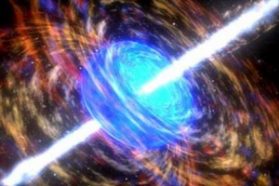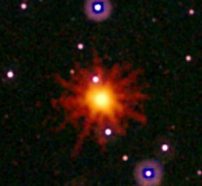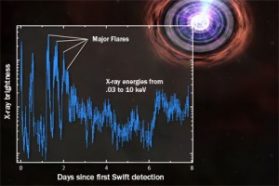A curious cosmic explosion
A bright blowup far, far away keeps astronomers guessing

Astronomers know a lot about what’s out there. They discover distant galaxies, spot supernovas and find small, strange planets millions of light-years away.
But occasionally something happens that doesn’t exactly fit with what scientists already know, and astronomers search for a reasonable explanation. The mystery may be close to something they already know. Or it may be something new altogether — and that was the case with a recent deep-space event that wouldn’t go away.
On March 28, NASA’s Swift satellite spotted an explosion in the Draco constellation, in the northern part of the sky. This bright blowup didn’t appear unusual at first: It looked like a gamma-ray burst, which is a bright blast of powerful radiation that usually lasts about 30 seconds. Sometimes gamma-ray bursts last for hours. Gamma rays are the most energetic type of radiation in the universe, and astronomers suspect bursts of these rays can be emitted when a massive star dies.
But this recent explosion didn’t go away after 30 seconds — or after a few hours. A day later, it was still there. A week later, it was still there. As of April 22, the blast had been going strong for 26 days. During that time, it brightened and dimmed many times, and the bright pulses sometimes lasted hundreds of seconds. If it is a gamma-ray burst, it’s breaking all kinds of records.

“It’s either a phenomenon we’ve never seen before or a familiar event that we’ve never viewed in this way before,” Andrew Fruchter told Science News. Fruchter is an astronomer at the Space Telescope Science Institute in Baltimore.
He’s got an idea about what happened: A black hole might have eaten a star that moved too close. We usually think about black holes as places where nothing can escape, but deep-space images show that powerful jets of radiation can shoot across the cosmos from the neighborhood of a black hole.
Fruchter suggests that as the black hole pulled in gas from the star, the black hole could have produced a blast of gamma rays and X-rays. The jet may have been pointed straight at Earth — in which case our telescopes are looking right down the middle of the high-energy radiation stream.
On April 4, the Hubble Space Telescope took a picture of the explosion and identified it as happening in the center of a galaxy 3.8 billion light-years away. (A light-year is the distance traveled by light in one year. To travel one light-year, you’d have to go to the sun and back about 30,000 times.) That faraway galaxy probably has a giant black hole at its center, which could be the source of the radiation. The Hubble picture offers more evidence that the black hole gobbled a star and then sent out an explosion of radiation jets.

“If we are indeed seeing a black hole swallow a star, then it may be that the black hole has nearly finished its meal, and it is just eating the remaining crumbs now,” said Fruchter.
A demolished star would be an unusual source of a gamma-ray burst. Astronomers would normally expect gamma-ray bursts to develop in a different way: when a dying star explodes in a supernova and then collapses to become a black hole or neutron star. Stan Woosley, an astronomer at the University of California, Santa Cruz, thinks this process could explain the explosion that won’t stop. In this case, he told Science News, a very large star might have collapsed to become a black hole, and it’s taking a relatively long time for the newborn black hole to produce all the radiation.
With tools and technology like the Swift satellite and the Hubble Space Telescope, the long-lived explosion may not be a mystery for long. On the other hand, the blowup could point to a deep-space occurrence that has never been observed until now.
POWER WORDS (adapted from the New Oxford American Dictionary)
supernova A dying star that suddenly increases greatly in brightness because of a catastrophic explosion that ejects most of the star’s mass.
gamma rays Electromagnetic radiation with the highest energy and the shortest waves. It is very similar to X-rays.
electromagnetic radiation The waves that carry energy, including visible light, radio waves, gamma rays and X-rays.
black hole A place in space where gravity is so strong no light or matter can escape. Astronomers suspect black holes exist at the center of most large galaxies.
neutron star A small object with very high density. Astronomers believe neutron stars form when large stars undergo a supernova but aren’t big massive enough to form a black hole.
phenomenon Something that is surprising or out of the ordinary.







